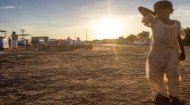|
As ever across Africa, 'free education' is something of an illusion especially for poor familes as while the teaching is free, books, materials and other supplies are not and traditional views of the role of women mean fewer girls attend, and remain in, school. Overall the adult literacy rate in 2018 was 60.7%, but higher for youths at 70.9% although, a few years earlier when the last figures were available, that stood at just 50.2% for girls.  On leaving school 80% of children will end up working in agriculture with a further 10% in industry and commerce and a further 6% in government offices. On leaving school 80% of children will end up working in agriculture with a further 10% in industry and commerce and a further 6% in government offices.
Very few skilled professionals stay in the country as wages are so low so those who can, including doctors and engineers, tend to move abroad to take up positions in the USA and Europe. Although most of the workforce are engaged in subsistence farming, that work only contributes around 35% of Sudan's GDP and isn't a reliable source of food given the more frequently occuring droughts.
 According to UNICEF, an estimated 2.7 million children under five in Sudan suffer from malnutrition every year with over half a million of those experiencing severe acute malnutrition. 50% of this is attributed to repeated diarrhoea or worm infections. The situation is worse for the 370,000 Sudanese refugees from Darfur who are encamped along the Chad border. According to UNICEF, an estimated 2.7 million children under five in Sudan suffer from malnutrition every year with over half a million of those experiencing severe acute malnutrition. 50% of this is attributed to repeated diarrhoea or worm infections. The situation is worse for the 370,000 Sudanese refugees from Darfur who are encamped along the Chad border.
Water itself is a growing serious issue for children in southern Sudan in particular where small boreholes are the main source of water with people walking miles, then queuing for hours to get supplies of untreated water resulting in many suffering from bacterial and protozoal diarrhoea, hepatitis A and E, and typhoid fever ~ all water related. Cholera and diarrhoea themselves are the leading causes of death among children in South Sudan. All this in a country ranked in 172nd place out of 191 in 2021 in terms of poverty and living standards that are significantly below that of other Arab states and even low human development.
The ongoing conflicts in Sudan won't be discussed here save to say many children are severely traumatised; the scars in society are not a brief period in their country's history as, for children, they have known no other history. Within this group of children are those known as the 'Lost Boys of Sudan' who were displaced during the country's second civil war. The video above shows aspects of daily life in Sudan. There are a few charities you can contact to help children there together with child sponsor programs.
|

 In rural Sudan most live in simple houses with around half being 'gottias' or 'tukuls'. These are traditional mud-built round huts with straw roofs and are normally just one room. Others are called 'menzils', a term dating back to the early 1900s when women were known as 'rabbit menzils', that is someone who stayed in the house performing household chores such as cooking and cleaning. Menzils tend to be larger with some having an indoor latrine.
In rural Sudan most live in simple houses with around half being 'gottias' or 'tukuls'. These are traditional mud-built round huts with straw roofs and are normally just one room. Others are called 'menzils', a term dating back to the early 1900s when women were known as 'rabbit menzils', that is someone who stayed in the house performing household chores such as cooking and cleaning. Menzils tend to be larger with some having an indoor latrine.







 On leaving school 80% of children will end up working in agriculture with a further 10% in industry and commerce and a further 6% in government offices.
On leaving school 80% of children will end up working in agriculture with a further 10% in industry and commerce and a further 6% in government offices.  According to UNICEF, an estimated 2.7 million children under five in Sudan suffer from malnutrition every year with over half a million of those experiencing severe acute malnutrition. 50% of this is attributed to repeated diarrhoea or worm infections. The situation is worse for the 370,000 Sudanese refugees from Darfur who are encamped along the Chad border.
According to UNICEF, an estimated 2.7 million children under five in Sudan suffer from malnutrition every year with over half a million of those experiencing severe acute malnutrition. 50% of this is attributed to repeated diarrhoea or worm infections. The situation is worse for the 370,000 Sudanese refugees from Darfur who are encamped along the Chad border.


